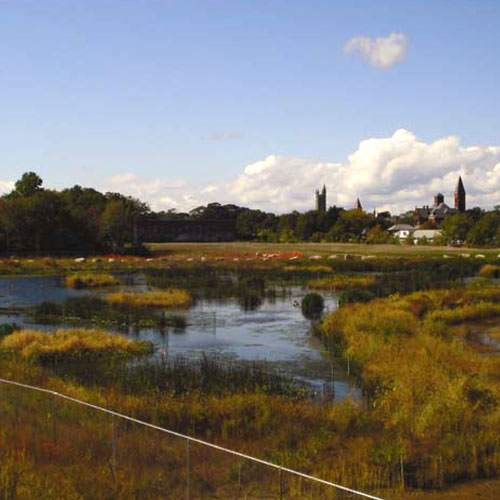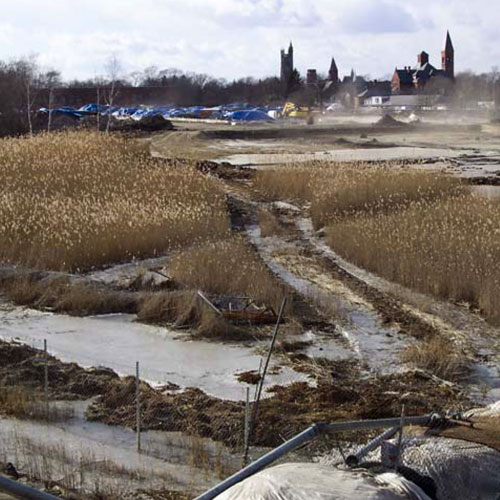
Principles for Ecological Land Reuse
- Home
- EPA Presentations
- Principles for Ecological Land Reuse
- Soil Science
- Soil Amendments
- Terrestrial Carbon Sequestration
- Plants and Revegetation
- Growing Gardens in Urban Soils
- Ecosystem Services
- Creating Pollinator Habitats as Part of an Ecological Revitalization Project
- Act Locally
- Land Revitalization Assistance
- Case Study Profiles
- Publications, Resources, and Links
- Glossary of Ecological Land Reuse Terms

Develop and Communicate Ecology Awareness and Procedures. The process of ecological revitalization begins in the assessment or investigation phase, not after the remedy has been designed and is underway. Contractors and construction engineers are often not cognizant of sensitive ecological areas or aware that they can minimize disturbance and protect the ecology. Cleanup project managers can articulate a preservation policy and distribute it to everyone involved with on-site activities. Cleanup project managers can also incorporate requirements to protect habitat or species into construction plans, specifications, and contracts, as appropriate.
Design a Property-Wide Work Zone and Traffic Plan. The cleanup project manager can delineate staging areas, work zones, and traffic patterns to minimize unnecessary disruption of sensitive areas and existing habitat on or near a property. The cleanup team can delineate areas not requiring surface disruption and areas off-limits to disturbance, such as steep slopes, sensitive habitats, and clean stream corridors, with fences, tape, or sign to avoid disturbance by property workers and equipment.
Minimize Excavation and Retain Existing Vegetation. Earthmoving can destroy the roots of trees and other plants as well as disturb vegetation in uncontaminated areas. In addition, compaction of soil is also damaging to roots. These activities can be restricted to areas essential for the cleanup and avoided in all other areas. Some areas with low contamination levels or immobile contaminants posing no unacceptable risk to human health or the environment may be better off left undisturbed, if the disruptive effects of excavation outweigh the benefits of further cleanup, especially in valuable habitats. Treatment and monitoring technologies are less invasive cleanup measures than excavation.
Phase Site Work. Sometimes cleanup project managers can phase construction by stabilizing one area of the property before disturbing another. This approach can reduce total soil erosion for the entire property and allows for revegetation or redevelopment of some areas immediately after cleanup. The cleanup project manager can also schedule construction to minimize the area of soil exposed during periods of heavy or frequent rains, and avoid sensitive periods (breeding, nesting, etc.) of certain species.
Consider Property Characteristics. During the ecological revitalization of a property and to increase chances of successful revitalization, it is important that ecologists consider the following property characteristics: property size, existing habitat, proximity to undisturbed areas, topography, natural water supply, access, biodiversity (preserved by establishing connections between habitats or enlarging habitats), contaminant bioaccumulation (assessed during an ERA [EPA 1998, 1999a]), health of species and ecosystems, and threatened and endangered species (usually involves the assistance of a professional biologist or ecologist). Consider surrounding habitat when selective native species for revegetation to increase chances of success. Urban properties pose additional challenges because they are typically small and may be subject to heavy runoff containing pollutants.
Protect On-site Fauna. In some cases, the project team may temporarily relocate on-site fauna that is being protected. Relocation may involve humane trapping and release, but less disruptive techniques may also be effective. For example, to relocate beavers and alligators at the French Limited Superfund Site in Crosby, Texas, project managers reduced their food supply in areas to be treated and increased the food supply in other areas of the property. To protect fauna such as snakes, turtles, and some nesting birds that prefer edge habitat, it is necessary to consider careful use and parking of construction equipment in sensitive areas. For example, using construction equipment on edge habitat, or even using it to store equipment or fill material can adversely affect these species.
Locate and Manage Waste and Soil Piles to Minimize Erosion. Property cleanup may include the creation of temporary waste or soil piles to store contaminated soil for treatment or to store treated soil before redeposition. To minimize disruption of the local habitat, the cleanup project manager can structure stockpiles to minimize runoff; locate them away from steep slopes, wetlands, streams, or other sensitive areas, place them away from tree root zones to avoid soil compaction, and cover or stabilize them to control erosion and dust.
Design Containment Systems with Habitat Considerations. Building containment systems usually removes existing biota but can greatly improve the habitat, especially if the contamination present has severely degraded the area. While revegetation over containment areas or treatment systems must not detract from the effectiveness of the cleanup, cleanup project managers can design the cleanup components with ecological revitalization in mind. Cleanup project managers may also want to consider the type of contaminants, their stability, the media through which they travel, and the anticipated future land use. In addition, they may choose to avoid features that could damage the containment system or create an attractive nuisance. Where feasible, plan to allow enough soil above the protective cover to support the root systems of the intended vegetation. The use of fencing, removing access to potential food sources, or providing sufficient soil cover over the contaminated material can discourage wildlife from coming into contact with the contaminated material or from damaging a containment area.
Reuse Indigenous Materials Whenever Practical. Reusing logs, rocks, brush, or other materials found on site can provide logistical and ecological advantages as well as cost savings. Topsoil from on-site sources is usually well suited to support native vegetation. Treated soil and other materials can also be used as backfill, reducing the need for borrow areas for clean fill. Green waste, such as logs and branches can be used on site, to a limited degree, to create structure within the new habitats. Excess woody material can be shredded, composted, and used as a soil amendment. For example, at Loring Air Force Base in Northeastern Maine, boulders and cobbles, larger than 15 centimeters in diameter, were removed from the streambed and nearby trees during cleanup and later used in stream reconstruction, after completion of cleanup activities. Reuse of native materials at this property significantly reduced the need for additional materials and thereby achieved cost savings.
Control Erosion and Sedimentation. Revitalization areas usually need erosion and sedimentation control measures to avoid disturbing sensitive areas, even when state or local regulations do not require them. These measures can include retaining sediment on the property and managing runoff using filters, such as compost or other organic materials.
Ensure that Borrow Areas Minimize Impact on Habitat. Borrow areas, locations where cleanup teams excavate clean soil for use elsewhere during a cleanup, may be located and used with ecological revitalization objectives in mind. For example, borrow areas can be located in low-value areas to create or improvise habitat and be designed, contoured, and vegetated to meet aesthetic and habitat considerations. Based on consultations with the USFWS, project managers at the Rocky Mountain Arsenal designed borrow areas to establish the habitat of a planned wildlife refuge.
Avoid Introducing New Sources of Contamination. If not properly managed, cleanup activities can introduce new sources of contamination that may affect habitat and ecological receptors. Contamination can result from materials used on the property, fugitive dust emissions, and operations of equipment and sanitation facilities. Materials that can cause contamination include pesticides, herbicides, fertilizers, petroleum products, treatment agents, and solid wastes. To avoid introducing these new sources, storage areas can be sheltered from the elements, lined with plastic sheeting, surrounded by berms, and regularly inspected for releases. In addition, equipment maintenance can be done in suitable staging areas and adequate sanitation facilities for property workers can be provided away from streams, wetlands, and other sensitive areas.
Prevent the Introduction of Undesirable Species. Non-native plant species can invade and destroy native species. To prevent introducing undesirable species, monitor barren and disturbed areas, which are susceptible to colonization by undesirable plants, and remove undesirable species where necessary. In addition, equipment operators can wash trucks and equipment before entering a property to avoid introducing invasive plant seeds. Clothing and shoes can also be managed to avoid introducing invasive plant seeds.
In restoring a site for ecological land reuse, consider the green remediation best management practices (BMPs) that can be employed at the site (e.g., using energy effficint equipment, integrating renewable energy sources to power equipment, limiting engine idling time for machinery). Incorporating green remediation BMPs at the beginning of the ecological land reuse process will minimize the environmental footprint of your project. Visit the CLU-IN Green Remediation Focus area page for more information on green remediation BMPs, practices, policies, and news.






